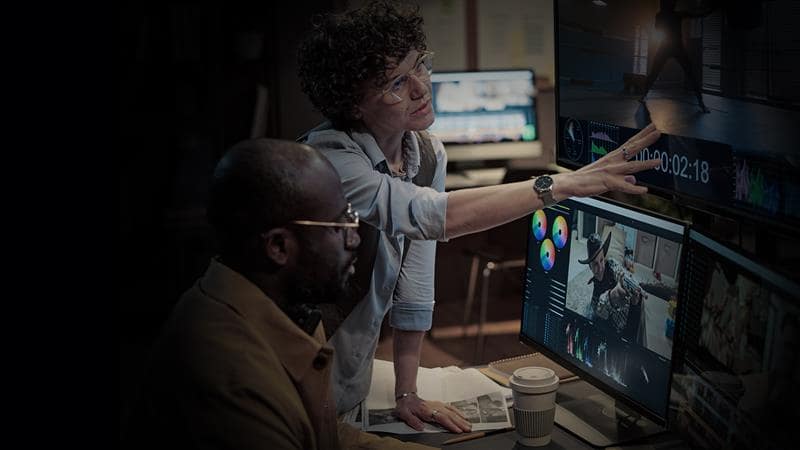
In today’s dynamic media landscape, traditional post-production workflows are evolving into intelligent, AI-powered video collaboration systems. With demand for content rising and remote teams becoming the norm, AI—especially through the use of AI agents—is now central to streamlining workflows, boosting productivity, and enabling seamless collaboration across global teams.
In this guide, we’ll explore how AI is transforming video collaboration, backed by industry examples and key statistics.
How is AI transforming video collaboration workflows?
Automated Editing and Assembly
One of the most time-consuming aspects of post-production is the assembly of footage into rough cuts. AI-based editing solutions can analyze footage, identify key scenes, and even suggest initial cuts based on factors such as emotion, pacing, and context. AI can also auto- generate rough cuts, allowing editors to focus on refining the narrative rather than starting from scratch.
IBM Watson collaborated with 20th Century Fox to create the first-ever AI-edited movie trailer for the horror film Morgan. Watson analyzed thousands of previous horror trailers, learning what elements worked best, and then suggested scenes from the movie to include in the trailer. This reduced the manual labor associated with editing and created a product that met audience expectations.
These capabilities are now embedded into cloud-native platforms like CLEAR®, where AI editing agents assist editors by offering scene suggestions and auto-generating timelines, enabling faster creative workflows.
Automated Metadata Tagging
Today, automated metadata tagging is a core capability of intelligent video collaboration systems. Platforms like CLEAR® leverage AI to tag people, emotions, locations, and logos, dramatically improving content discoverability and reuse across distributed teams.
Sky UK utilizes AI to enhance its sports and news post-production workflows. AI systems automatically tag metadata in real-time, allowing editors to quickly search for and retrieve specific footage for highlights, promotional content, or news recaps.
AI Agents Driving Workflow Automation
AI agents—autonomous tools built into media workflow platforms—now handle key repetitive tasks such as quality checks, compliance tagging, audio detection, and asset delivery. These agents also power AI-assisted review cycles, intelligently identifying key differences between content versions. With AI-based comparison, reviewers get automated assistance to pinpoint color, zoom, and textual changes across frames, reducing dependence on exhaustive manual reviews and maintaining near frame-accuracy across compliance, VFX, and versioning workflows.
AI-Enhanced Color Grading
Now integrated into collaborative workflows, AI-assisted grading tools support remote colorists working across time zones—ensuring consistent tone and faster turnarounds.
Netflix’s post-production teams use AI for color matching and scene-by-scene grading. This allows Netflix to handle the volume of content they produce, including hit shows like Stranger Things and The Witcher, where AI plays a significant role in achieving a unified visual tone across episodes.
AI-Assisted Review: Transforming Content Approval Cycles
In addition to automating editing, tagging, and grading, AI is redefining the content review and approval process itself. Traditional reviews are repetitive, time-consuming, and prone to human oversight. Enter the CLEAR® AI-assisted Review Co-Pilot, which revolutionizes review cycles by providing AI-generated visual maps of content changes, significantly reducing time-to-approval and increasing accuracy.
With side-by-side dual playback, AI highlights matched, unmatched, and moved scenes between versions, allowing reviewers to focus only on areas of change without watching entire footage. This cuts review cycles by up to 80%, accelerates production timelines, and reduces labor costs by up to 60%.
Beyond editorial reviews, Co-Pilot supports:
- Cut Reviews: Speeding up creative iterations
- Compliance Reviews: Ensuring regional and legal compliance swiftly
- VFX and Conform Checks: Detecting subtle differences in VFX-heavy content and validating up-resolution or localized masters
By combining patent-pending AI models, intuitive dual video playback, AI timelines, and time- coded comments, CLEAR® empowers creative teams to review faster, smarter, and with greater confidence.
Enhanced Collaboration and Remote Workflows
Cloud-native video collaboration platforms like CLEAR® enable real-time access to shared assets, task automation via AI agents, and centralized feedback—bridging the gap between remote teams and helping deliver faster outputs. AI-assisted review tools like CLEAR® provide real-time notifications on review progress, offer downloadable AI comparisons, and allow seamless comment exports in EDL/XML, integrating smoothly with downstream editing teams. This means fewer review cycles, quicker sign-offs, and higher creative velocity for globally distributed teams.
Conclusion
AI is revolutionizing media workflows—moving from isolated post-production tools to intelligent, AI-powered video collaboration platforms. With the help of AI agents, cloud MAM, and automation, companies can accelerate delivery, improve quality, and enhance team collaboration. CLEAR® by Prime Focus Technologies is a powerful example of how AI-first design transforms the way teams create, manage, and deliver content at scale.
WHAT'S NEXT